Page 514 of 650
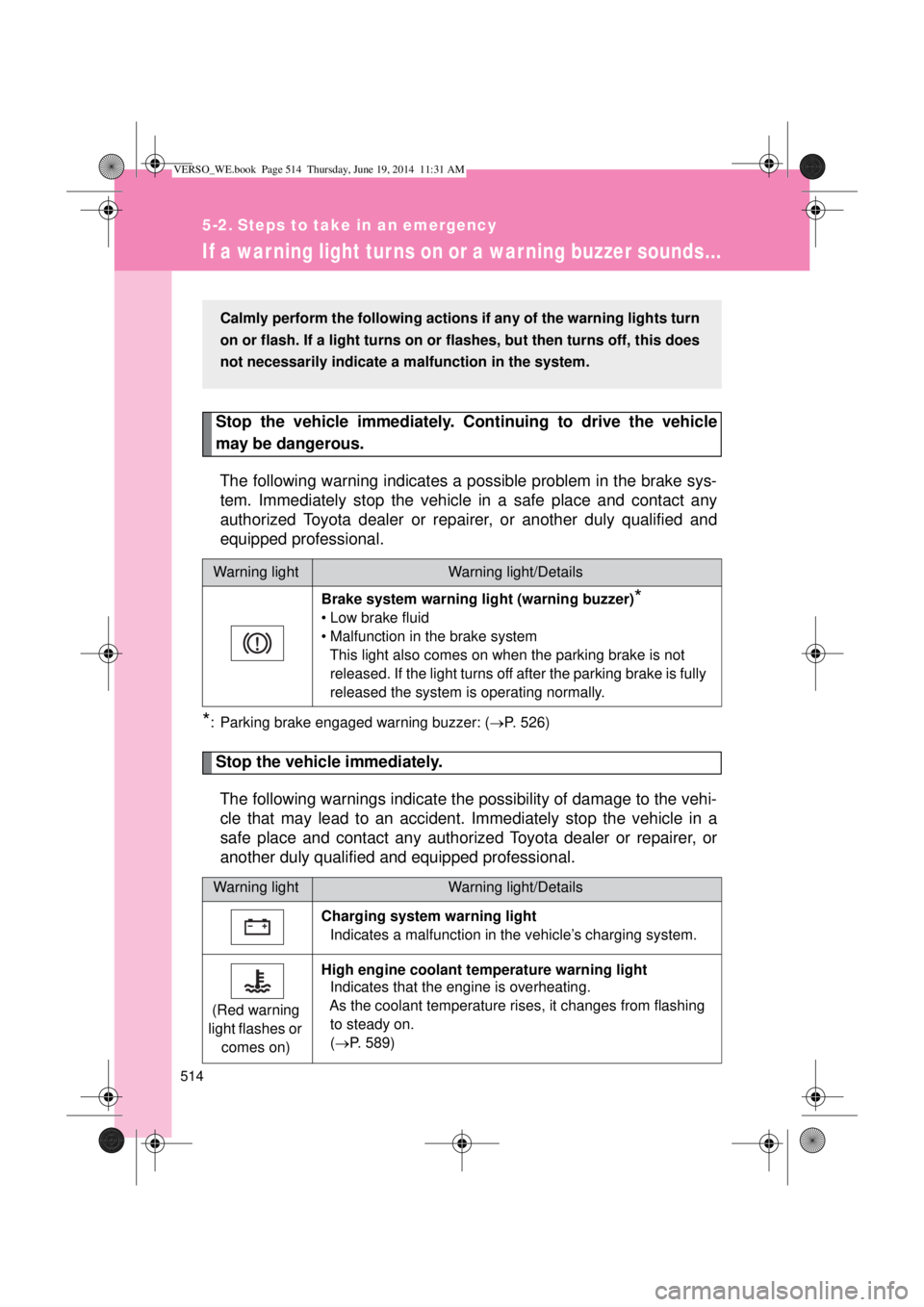
514
5-2. Steps to take in an emergency
If a warning light turns on or a warning buzzer sounds...
Stop the vehicle immediately. Continuing to drive the vehicle
may be dangerous.
The following warning indicates a possible problem in the brake sys-
tem. Immediately stop the vehicle in a safe place and contact any
authorized Toyota dealer or repairer, or another duly qualified and
equipped professional.
*: Parking brake engaged warning buzzer: (P. 526)
Stop the vehicle immediately.
The following warnings indicate the possibility of damage to the vehi-
cle that may lead to an accident. Immediately stop the vehicle in a
safe place and contact any authorized Toyota dealer or repairer, or
another duly qualified and equipped professional.
Warning lightWarning light/Details
Brake system warning light (warning buzzer)
*
• Low brake fluid
• Malfunction in the brake system
This light also comes on when the parking brake is not
released. If the light turns off after the parking brake is fully
released the system is operating normally.
Warning lightWarning light/Details
Charging system warning light
Indicates a malfunction in the vehicle’s charging system.
(Red warning
light flashes or
comes on)High engine coolant temperature warning light
Indicates that the engine is overheating.
As the coolant temperature rises, it changes from flashing
to steady on.
(P. 589)
Calmly perform the following actions if any of the warning lights turn
on or flash. If a light turns on or flashes, but then turns off, this does
not necessarily indicate a malfunction in the system.
VERSO_WE.book Page 514 Thursday, June 19, 2014 11:31 AM
Page 527 of 650
5
527 5-2. Steps to take in an emergency
When trouble arises
(Flashes)Indicates that the
parking brake is still
engaged.
A buzzer sounds to
indicate that parking
brake is still engaged
(with the vehicle hav-
ing reached a speed
of more than 5 km/h [3
mph]).Release the parking
brake.
*1Indicates that the Mul-
tidrive or automatic
transmission fluid
temperature is too
high.
A buzzer also sounds.Stop the vehicle in a
safe place and shift
lever to “P”.
If the light does not go
off, contact any autho-
rized Toyota dealer or
repairer, or another duly
qualified and equipped
professional.
*2
Indicates that engine
oil level is low.
A buzzer also sounds.Check the level of
engine oil, and add if
necessary.
(Flashes)Indicates that the
headlight switch is left
on (with the key
removed and the
driver’s door opened).
A buzzer also sounds.Turn the headlight
switch off.
Warning messageDetailsCorrection procedure
VERSO_WE.book Page 527 Thursday, June 19, 2014 11:31 AM
Page 536 of 650
536
5-2. Steps to take in an emergency
If you have a flat tire (vehicles with spare tire)
Remove the flat tire and replace it with the spare provided.
Before jacking up the vehicle
Stop the vehicle on a hard, flat surface.
Set the parking brake.
Shift the shift lever to “P” (Multidrive or automatic transmis-
sion) or “R” (manual transmission).
Stop the engine.
Turn on the emergency flashers. (P. 502)
Location of the spare tire, jack and tools
Vehicles without the third seat
Spare tire
Jack
handleJack
Wheel nut wrench
Towing eyelet
VERSO_WE.book Page 536 Thursday, June 19, 2014 11:31 AM
Page 552 of 650
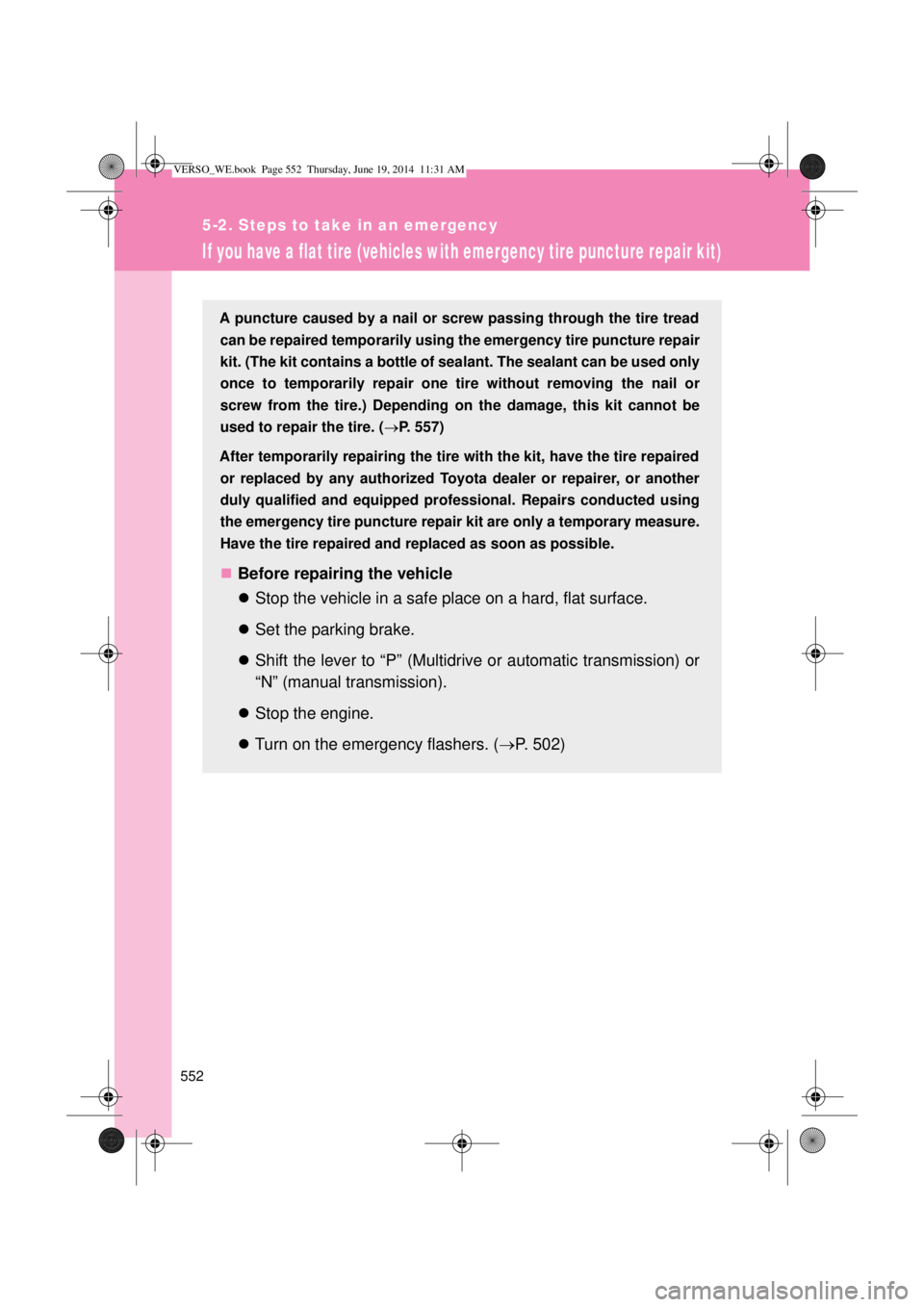
552
5-2. Steps to take in an emergency
If you have a flat tire (vehicles with emergency tire puncture repair kit)
A puncture caused by a nail or screw passing through the tire tread
can be repaired temporarily using the emergency tire puncture repair
kit. (The kit contains a bottle of sealant. The sealant can be used only
once to temporarily repair one tire without removing the nail or
screw from the tire.) Depending on the damage, this kit cannot be
used to repair the tire. (P. 557)
After temporarily repairing the tire with the kit, have the tire repaired
or replaced by any authorized Toyota dealer or repairer, or another
duly qualified and equipped professional. Repairs conducted using
the emergency tire puncture repair kit are only a temporary measure.
Have the tire repaired and replaced as soon as possible.
Before repairing the vehicle
Stop the vehicle in a safe place on a hard, flat surface.
Set the parking brake.
Shift the lever to “P” (Multidrive or automatic transmission) or
“N” (manual transmission).
Stop the engine.
Turn on the emergency flashers. (P. 502)
VERSO_WE.book Page 552 Thursday, June 19, 2014 11:31 AM
Page 577 of 650
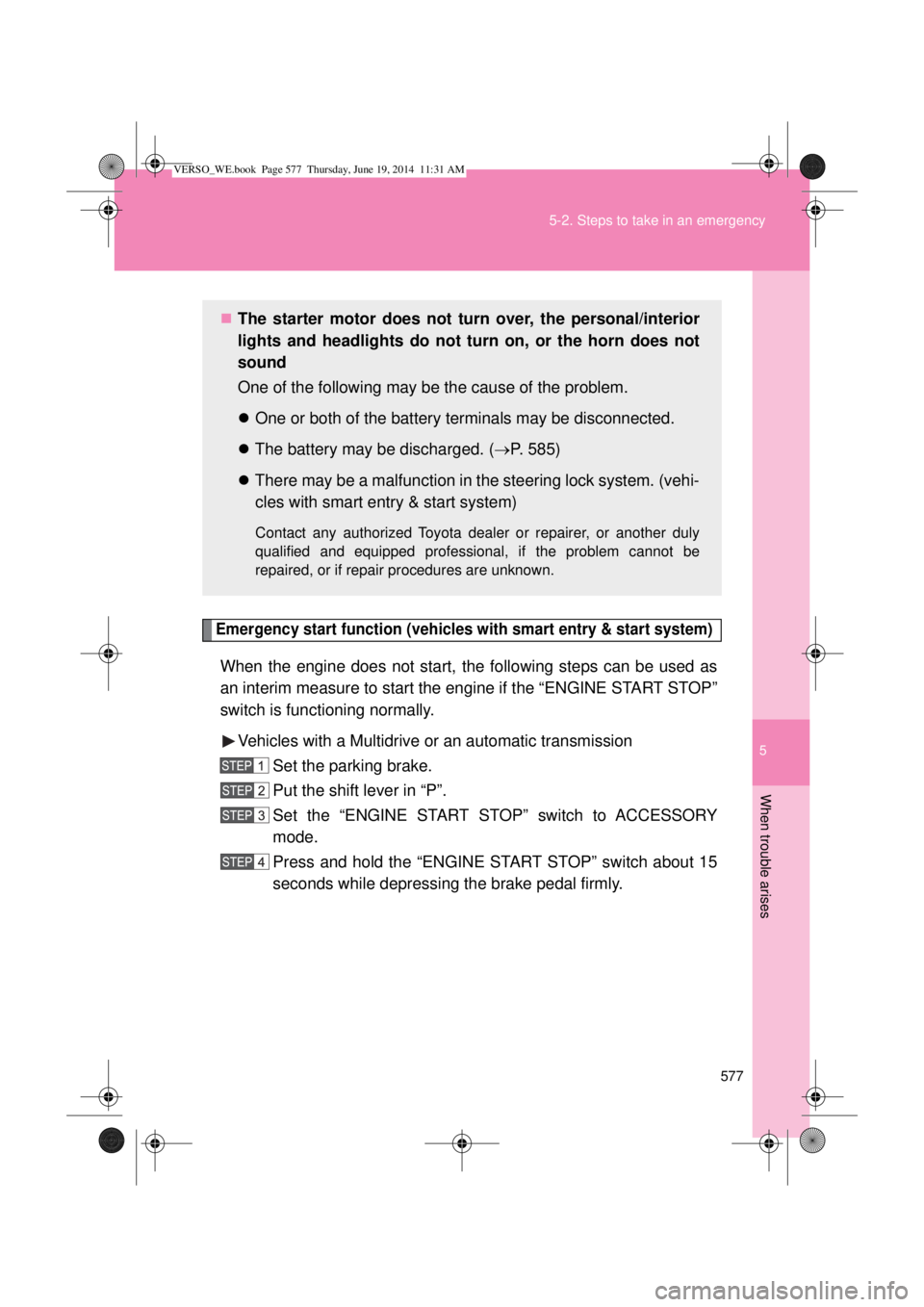
5
577 5-2. Steps to take in an emergency
When trouble arises
Emergency start function (vehicles with smart entry & start system)
When the engine does not start, the following steps can be used as
an interim measure to start the engine if the “ENGINE START STOP”
switch is functioning normally.
Vehicles with a Multidrive or an automatic transmission
Set the parking brake.
Put the shift lever in “P”.
Set the “ENGINE START STOP” switch to ACCESSORY
mode.
Press and hold the “ENGINE START STOP” switch about 15
seconds while depressing the brake pedal firmly.
The starter motor does not turn over, the personal/interior
lights and headlights do not turn on, or the horn does not
sound
One of the following may be the cause of the problem.
One or both of the battery terminals may be disconnected.
The battery may be discharged. (P. 585)
There may be a malfunction in the steering lock system. (vehi-
cles with smart entry & start system)
Contact any authorized Toyota dealer or repairer, or another duly
qualified and equipped professional, if the problem cannot be
repaired, or if repair procedures are unknown.
VERSO_WE.book Page 577 Thursday, June 19, 2014 11:31 AM
Page 578 of 650
578 5-2. Steps to take in an emergency
Vehicles with a manual transmission
Set the parking brake.
Put the shift lever in “N”.
Set the “ENGINE START STOP” switch to ACCESSORY
mode.
Press and hold the “ENGINE START STOP” switch about 15
seconds while depressing the brake pedal and clutch pedal
firmly.
Even if the engine can be started using the above steps, the system
may be malfunctioning. Have the vehicle checked by any authorized
Toyota dealer or repairer, or another duty qualified and equipped pro-
fessional.
VERSO_WE.book Page 578 Thursday, June 19, 2014 11:31 AM
Page 579 of 650
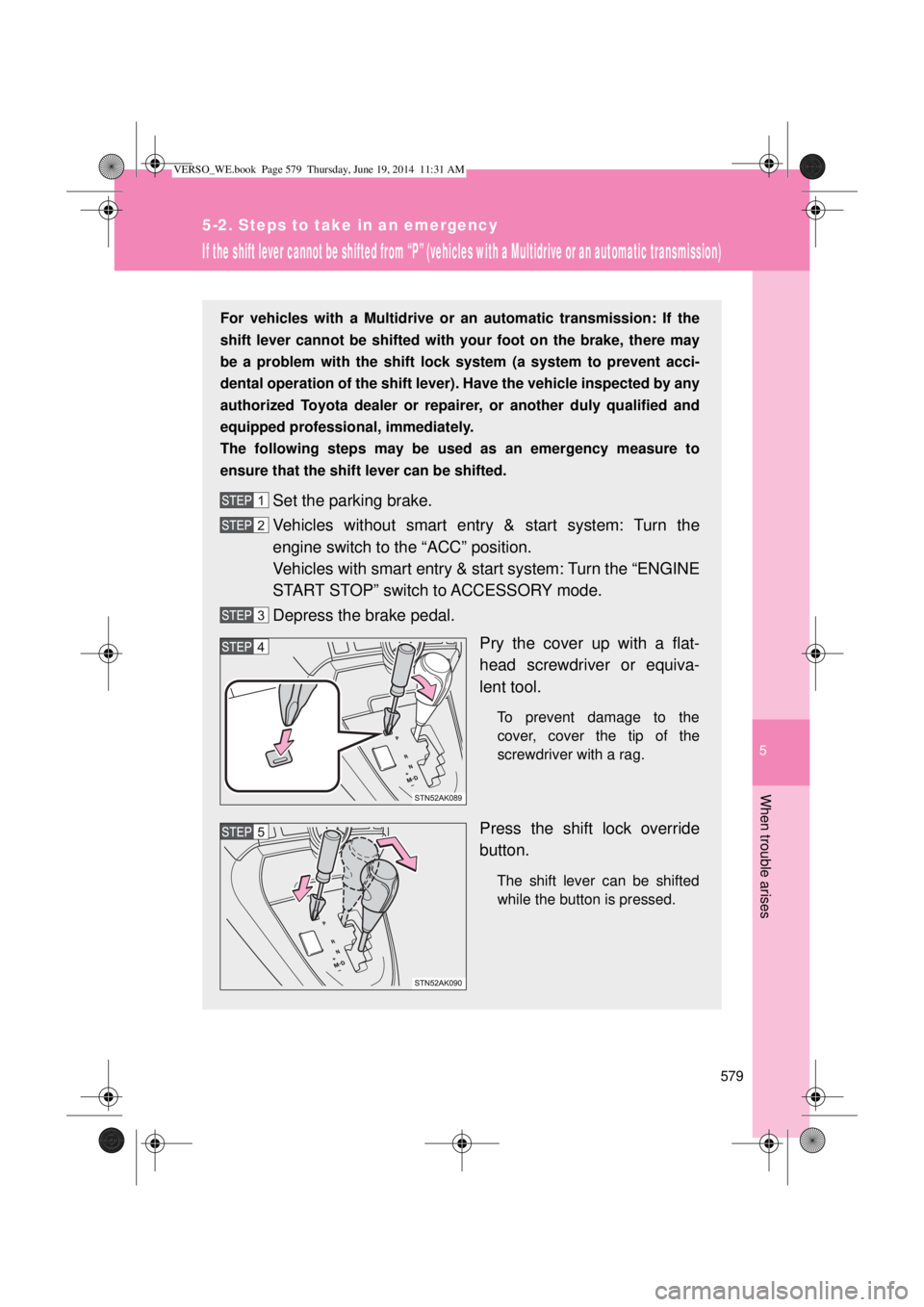
5
579
5-2. Steps to take in an emergency
When trouble arises
If the shift lever cannot be shifted from “P” (vehicles with a Multidrive or an automatic transmission)
For vehicles with a Multidrive or an automatic transmission: If the
shift lever cannot be shifted with your foot on the brake, there may
be a problem with the shift lock system (a system to prevent acci-
dental operation of the shift lever). Have the vehicle inspected by any
authorized Toyota dealer or repairer, or another duly qualified and
equipped professional, immediately.
The following steps may be used as an emergency measure to
ensure that the shift lever can be shifted.
Set the parking brake.
Vehicles without smart entry & start system: Turn the
engine switch to the “ACC” position.
Vehicles with smart entry & start system: Turn the “ENGINE
START STOP” switch to ACCESSORY mode.
Depress the brake pedal.
Pry the cover up with a flat-
head screwdriver or equiva-
lent tool.
To prevent damage to the
cover, cover the tip of the
screwdriver with a rag.
Press the shift lock override
button.
The shift lever can be shifted
while the button is pressed.
VERSO_WE.book Page 579 Thursday, June 19, 2014 11:31 AM
Page 593 of 650
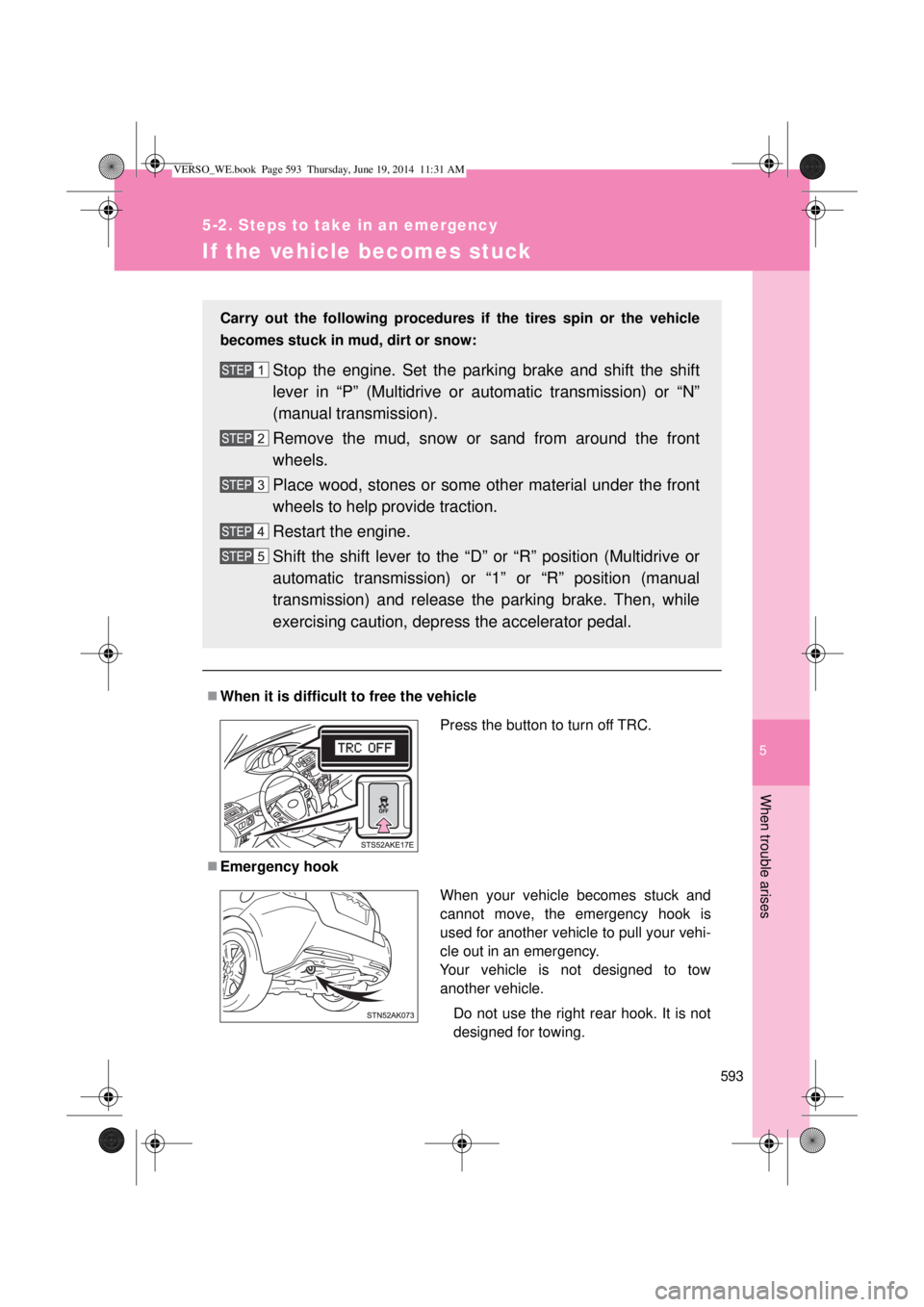
5
593
5-2. Steps to take in an emergency
When trouble arises
If the vehicle becomes stuck
When it is difficult to free the vehicle
Emergency hook Carry out the following procedures if the tires spin or the vehicle
becomes stuck in mud, dirt or snow:
Stop the engine. Set the parking brake and shift the shift
lever in “P” (Multidrive or automatic transmission) or “N”
(manual transmission).
Remove the mud, snow or sand from around the front
wheels.
Place wood, stones or some other material under the front
wheels to help provide traction.
Restart the engine.
Shift the shift lever to the “D” or “R” position (Multidrive or
automatic transmission) or “1” or “R” position (manual
transmission) and release the parking brake. Then, while
exercising caution, depress the accelerator pedal.
Press the button to turn off TRC.
When your vehicle becomes stuck and
cannot move, the emergency hook is
used for another vehicle to pull your vehi-
cle out in an emergency.
Your vehicle is not designed to tow
another vehicle.
Do not use the right rear hook. It is not
designed for towing.
VERSO_WE.book Page 593 Thursday, June 19, 2014 11:31 AM